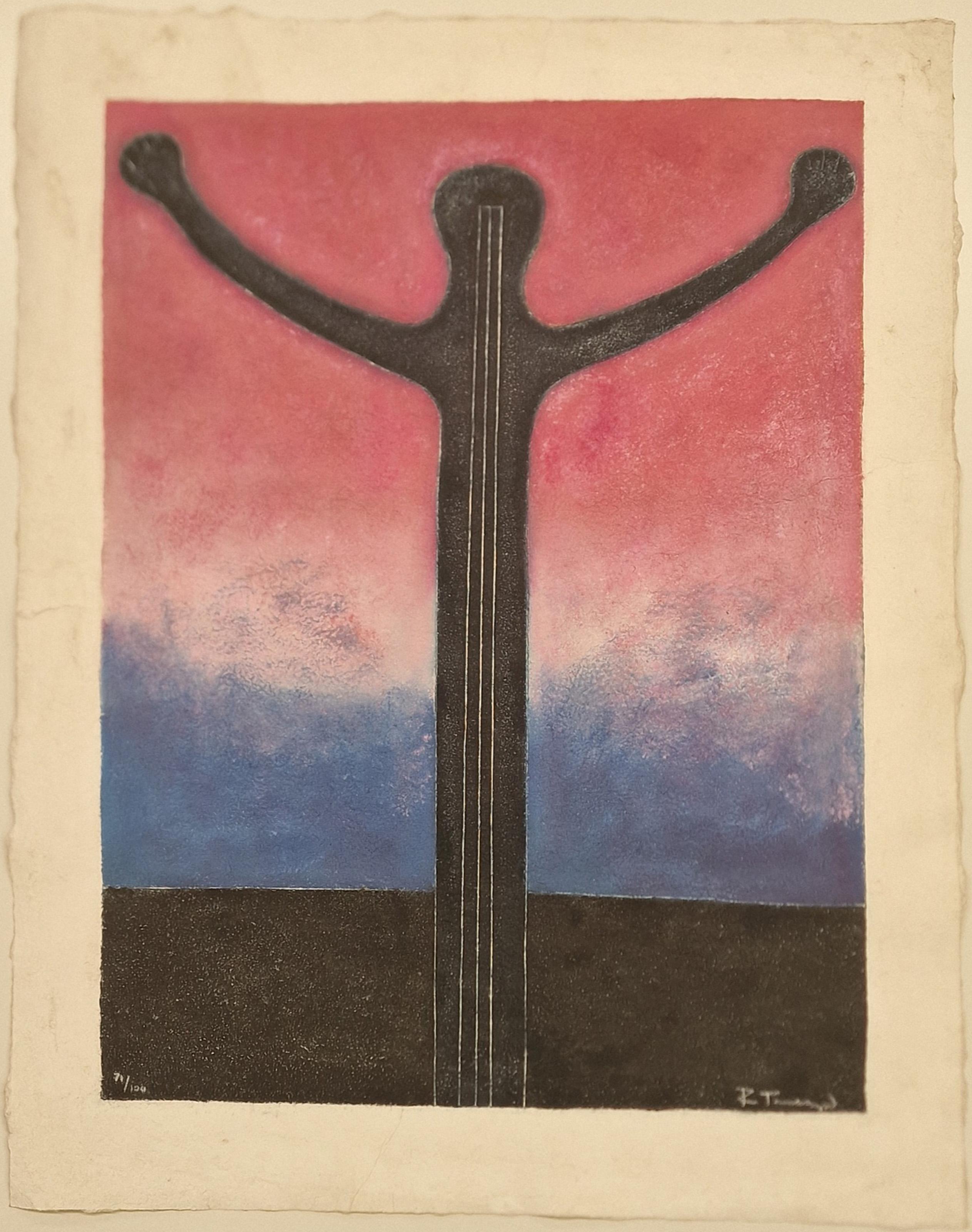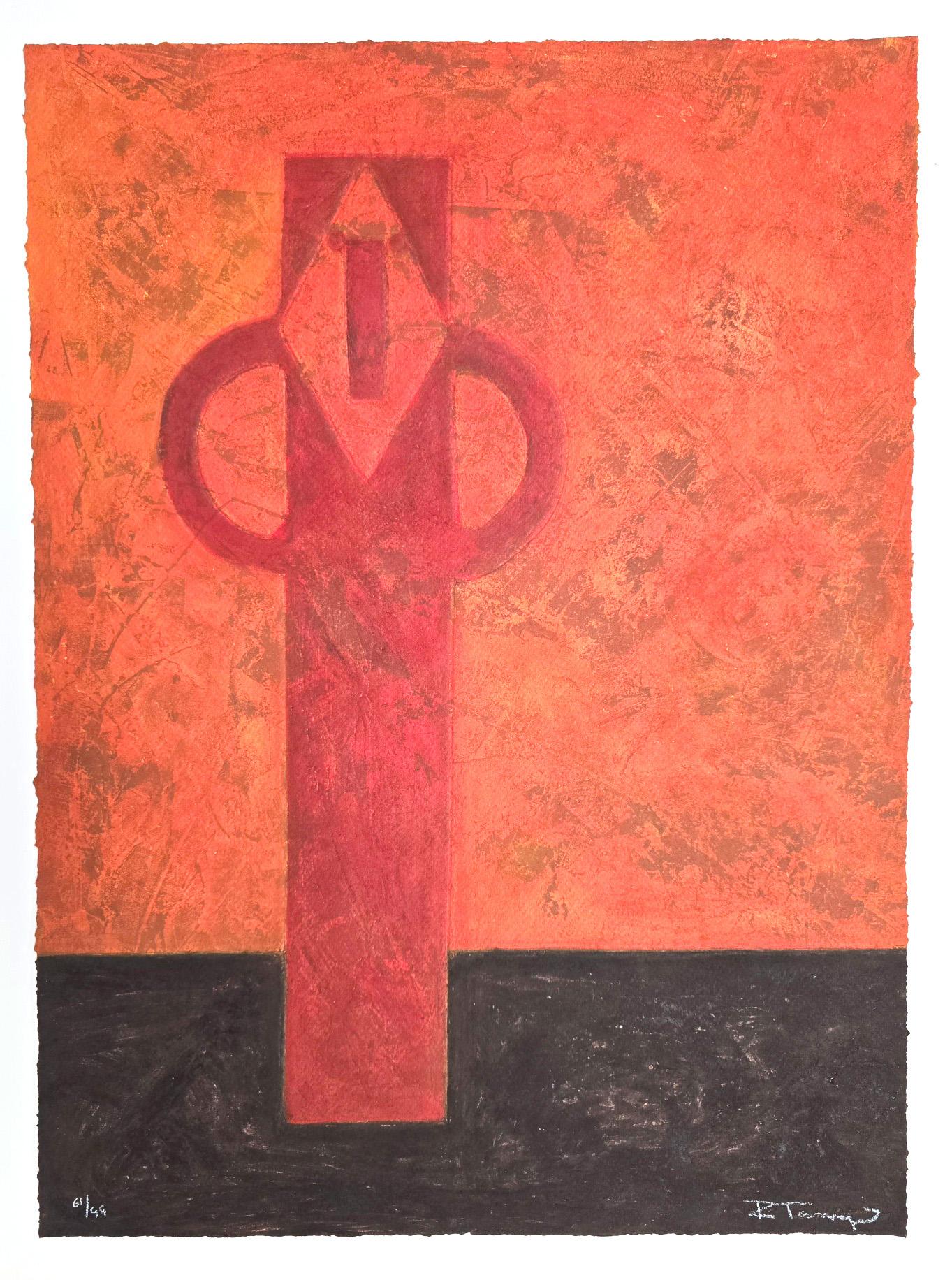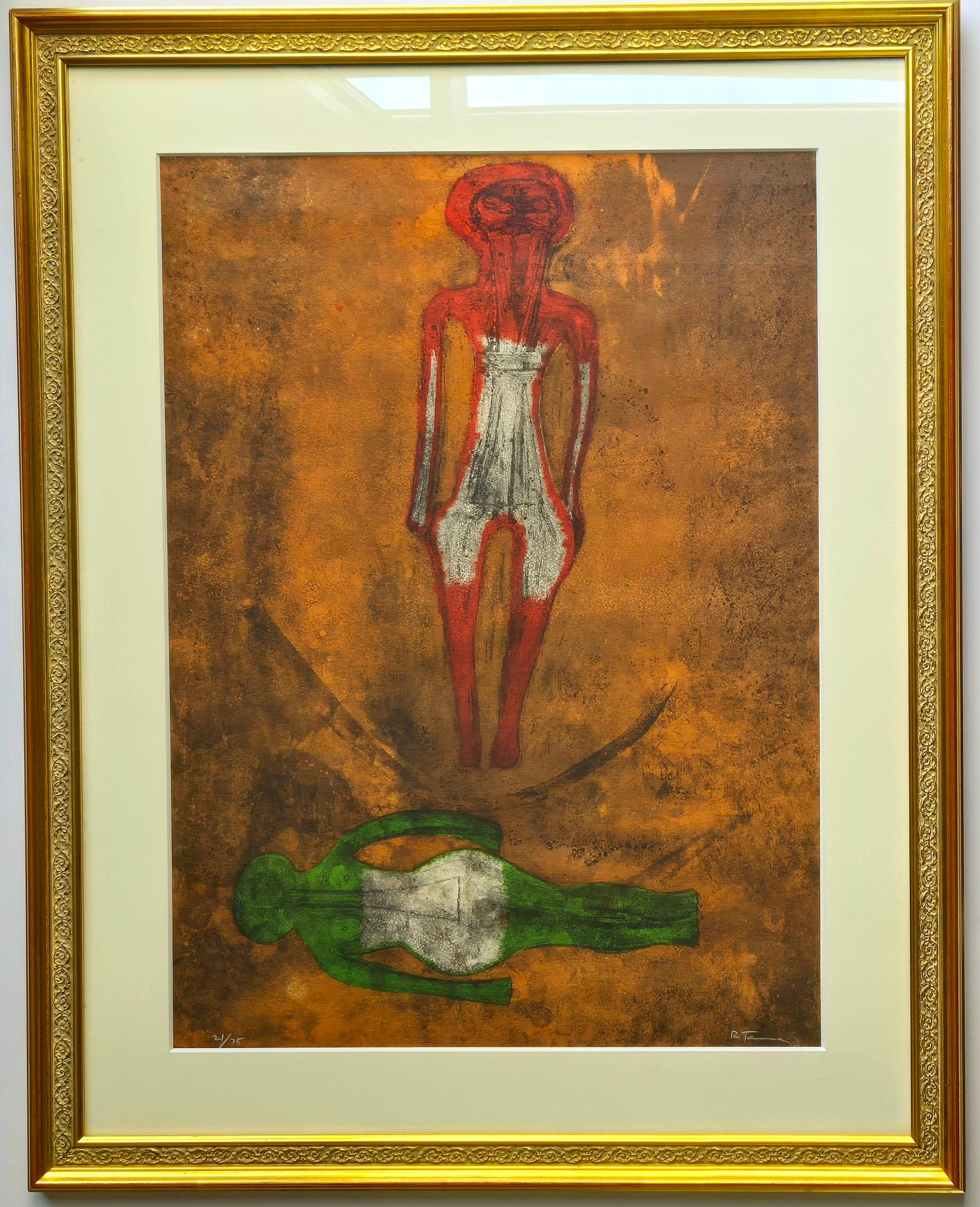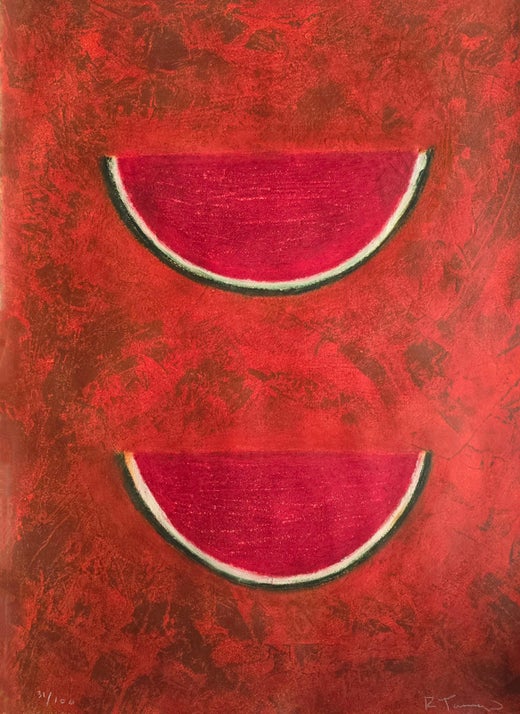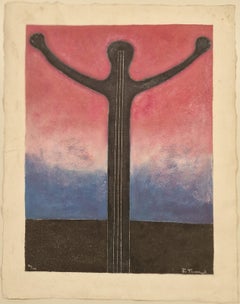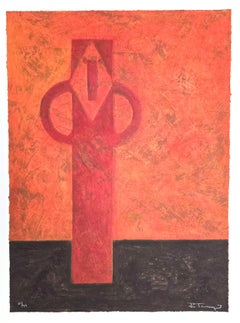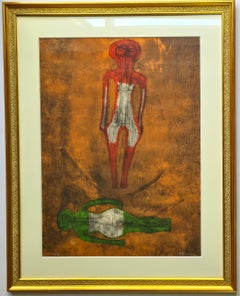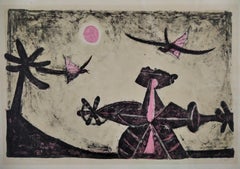Items Similar to Iron Cross
Want more images or videos?
Request additional images or videos from the seller
1 of 7
Rufino TamayoIron Cross1988
1988
$6,500
£4,915.55
€5,630.49
CA$9,108.06
A$9,942.94
CHF 5,235.08
MX$119,104.85
NOK 66,954.76
SEK 61,130.81
DKK 42,061.05
About the Item
Artist: Rufino Tamayo
Title: Iron Cross
Year: 1988
Medium: Color lithograph
Edition: Numbered CCXLV/CCC in pencil
Paper: Wove
Image size: 22.5 x 30.5 inches
paper Size: 27 x 35 inches
Signature: Hand signed in pencil by the artist
Publisher : XXIV Olympic Committe, Lloyd Shine Fine Arts
Printer: De Soto Workshop, San Francisco
Condition: Excellent
Description: Referenced and pictured in the artist's by catalogue raisonne Pereda, plate #332 page 268
Frame: Beautifully custom framed in a wooden silver frame, with fabric matting and silver color bevel.
- Creator:Rufino Tamayo (1899-1991, Mexican)
- Creation Year:1988
- Dimensions:Height: 42 in (106.68 cm)Width: 49 in (124.46 cm)Depth: 1.75 in (4.45 cm)
- Medium:
- Movement & Style:
- Period:
- Condition:
- Gallery Location:San Francisco, CA
- Reference Number:Seller: 102081stDibs: LU66632099173
Rufino Tamayo
Rufino Tamayo was born in Oaxaca, Mexico, in 1899 to parents Manuel Arellanes and Florentina Tamayo. Tamayo was active in the mid-20th century in Mexico and New York, painting figurative abstraction with surrealist influences. Although Tamayo studied drawing at the Academy of Art at San Carlos as a young adult, he became dissatisfied and eventually decided to study on his own.
About the Seller
5.0
Platinum Seller
Premium sellers with a 4.7+ rating and 24-hour response times
Established in 1999
1stDibs seller since 2017
872 sales on 1stDibs
Typical response time: <1 hour
- ShippingRetrieving quote...Shipping from: San Francisco, CA
- Return Policy
More From This Seller
View AllMascara Roja
By Rufino Tamayo
Located in San Francisco, CA
This artwork titled "Mascara Roja" 1969 is an original colors lithograph on B.F.K. Rives paper by renown Mexican artist Rufino Tamayo, 1899-1991. It is hand signed and inscribed H.C. (Hors Commerce) in pencil by the artist. The image size is 21 x 27.25 inches, framed size is 37.25 x 42 inches. Published by Touchtone Publisher, New York, printed by Ateliers Desjobert, Paris. Referenced and pictured in the artist's catalogue raisonne by Pereda, plate #124. Custom framed in a wooden gold leaf frame, with gold and red spacer and fabric matting. It is in excellent condition.
About the artist:
A native of Oaxaca in Southern Mexico, Rufino Tamayo's father was a shoemaker, and his mother a seamstress. Some accounts state that he was descended from Zapotec Indians, but he was actually 'mestizo' - of mixed indigenous/European ancestry. (Santa Barbara Museum of Art). He began painting at age 11. Orphaned at the age of 12, Tamayo moved to Mexico City, where he was raised by his maternal aunt who owned a wholesale fruit business.
In 1917, he entered the San Carlos Academy of Fine Arts, but left soon after to pursue independent study. Four years later, Tamayo was appointed the head designer of the department of ethnographic drawings at the National Museum of Archaeology in Mexico City. There he was surrounded by pre-Colombian objects, an aesthetic inspiration that would play a pivotal role in his life. In his own work, Tamayo integrated the forms and tones of pre-Columbian ceramics into his early still lives and portraits of Mexican men and women.
In the early 1920s he also taught art classes in Mexico City's public schools. Despite his involvement in Mexican history, he did not subscribe to the idea of art as nationalistic propaganda. Modern Mexican art at that time was dominated by 'The Three Great Ones' : Diego Rivera, Jose Clemente Orozco, and David Alfaro Siqueros, but Tamayo began to be noted as someone 'new' and different' for his blending of the aesthetics of post Revolutionary Mexico with the vanguard artists of Europe and the United States.
After the Mexican Revolution, he focused on creating his own identity in his work, expressing what he thought was the traditional Mexico, and refusing to follow the political trends of his contemporary artists. This caused some to see him as a 'traitor' to the political cause, and he felt it difficult to freely express himself in his art. As a result, he decided to leave Mexico in 1926 and move to New York, along with his friend, the composer Carlos Chavez. The first exhibition of Tamayo's work in the United States was held at the Weyhe Gallery, New York, in that same year. The show was successful, and Tamayo was praised for his 'authentic' status as a Mexican of 'indigenous heritage', and for his internationally appealing Modernist aesthetic. (Santa Barbara Museum of Art).
Throughout the late thirties and early forties New York's Valentine Gallery gave him shows. For nine years, beginning in 1938, he taught at the Dalton School in New York.
In 1929, some health problems led him to return to Mexico for treatment. While there he took a series of teaching jobs. During this period he became romantically involved with the artist Maria Izquierdo...
Category
Mid-20th Century Modern Figurative Prints
Materials
Lithograph
La Negra (The Black Woman)
By Rufino Tamayo
Located in San Francisco, CA
This artwork titled "La Negra (The Black Woman)" from the suite "The Mujeres File" 1969 is an original colors lithograph on B.F.K. Rives paper by renown Mexican artist Rufino Tamayo, 1899-1991. It is hand signed and numbered 150/150 in pencil by the artist. The image size is 26.85 x 21.25 inches, sheet size is 29.5 x 22.15 inches, framed size is 42 x 35 inches. Published by Touchtone Publisher, New York, printed by Ateliers Desjobert, Paris. Referenced and pictured in the artist's catalogue raisonne by Pereda, plate #109 page 107. Custom framed in a wooden silver frame, with silver spacer and fabric matting. It is in excellent condition.
About the artist:
A native of Oaxaca in Southern Mexico, Rufino Tamayo's father was a shoemaker, and his mother a seamstress. Some accounts state that he was descended from Zapotec Indians, but he was actually 'mestizo' - of mixed indigenous/European ancestry. (Santa Barbara Museum of Art). He began painting at age 11. Orphaned at the age of 12, Tamayo moved to Mexico City, where he was raised by his maternal aunt who owned a wholesale fruit business.
In 1917, he entered the San Carlos Academy of Fine Arts, but left soon after to pursue independent study. Four years later, Tamayo was appointed the head designer of the department of ethnographic drawings at the National Museum of Archaeology in Mexico City. There he was surrounded by pre-Colombian objects, an aesthetic inspiration that would play a pivotal role in his life. In his own work, Tamayo integrated the forms and tones of pre-Columbian ceramics into his early still lives and portraits of Mexican men and women.
In the early 1920s he also taught art classes in Mexico City's public schools. Despite his involvement in Mexican history, he did not subscribe to the idea of art as nationalistic propaganda. Modern Mexican art at that time was dominated by 'The Three Great Ones' : Diego Rivera, Jose Clemente Orozco, and David Alfaro Siqueros, but Tamayo began to be noted as someone 'new' and different' for his blending of the aesthetics of post Revolutionary Mexico with the vanguard artists of Europe and the United States.
After the Mexican Revolution, he focused on creating his own identity in his work, expressing what he thought was the traditional Mexico, and refusing to follow the political trends of his contemporary artists. This caused some to see him as a 'traitor' to the political cause, and he felt it difficult to freely express himself in his art. As a result, he decided to leave Mexico in 1926 and move to New York, along with his friend, the composer Carlos Chavez. The first exhibition of Tamayo's work in the United States was held at the Weyhe Gallery, New York, in that same year. The show was successful, and Tamayo was praised for his 'authentic' status as a Mexican of 'indigenous heritage', and for his internationally appealing Modernist aesthetic. (Santa Barbara Museum of Art).
Throughout the late thirties and early forties New York's Valentine Gallery gave him shows. For nine years, beginning in 1938, he taught at the Dalton School in New York.
In 1929, some health problems led him to return to Mexico for treatment. While there he took a series of teaching jobs. During this period he became romantically involved with the artist Maria Izquierdo...
Category
Mid-20th Century Modern Figurative Prints
Materials
Lithograph
Torso de Mujer
By Rufino Tamayo
Located in San Francisco, CA
This artwork titled "Torso de Mujer (Torso de Femmee)" from the suite "The Mujeres File" 1969 is an original colors lithograph on Wove paper by renown Mexican artist Rufino Tamayo, 1899-1991. It is hand signed and inscribed H.C. (Hors Commerce) in pencil by the artist. The image size is 26.85 x 21 inches, framed size is 40.75 x 33 inches. Published by Touchtone Publisher, New York, printed by Ateliers Desjobert, Paris. Referenced and pictured in the artist's catalogue raisonne by Pereda, plate #108 page 107. Custom framed in a wooden gold frame, with gold bevel and light beige fabric matting. It is in excellent condition.
About the artist:
A native of Oaxaca in Southern Mexico, Rufino Tamayo's father was a shoemaker, and his mother a seamstress. Some accounts state that he was descended from Zapotec Indians, but he was actually 'mestizo' - of mixed indigenous/European ancestry. (Santa Barbara Museum of Art). He began painting at age 11. Orphaned at the age of 12, Tamayo moved to Mexico City, where he was raised by his maternal aunt who owned a wholesale fruit business.
In 1917, he entered the San Carlos Academy of Fine Arts, but left soon after to pursue independent study. Four years later, Tamayo was appointed the head designer of the department of ethnographic drawings at the National Museum of Archaeology in Mexico City. There he was surrounded by pre-Colombian objects, an aesthetic inspiration that would play a pivotal role in his life. In his own work, Tamayo integrated the forms and tones of pre-Columbian ceramics...
Category
Mid-20th Century Modern Figurative Prints
Materials
Lithograph
Carnavalesque
By Rufino Tamayo
Located in San Francisco, CA
This artwork titled "Carnavalesque" from the suite "The Mujeres File" 1969 is an original colors lithograph on BFK Rives paper by renown Mexican artist Rufino Tamayo, 1899-1991. It i...
Category
Mid-20th Century Modern Figurative Prints
Materials
Lithograph
Venus Noir
By Rufino Tamayo
Located in San Francisco, CA
This artwork titled "venus Noir" from the suite "The Mujeres File" 1969 is an original colors lithograph on BFK Rives paper by renown Mexican artist Rufino Tamayo, 1899-1991. It is h...
Category
Mid-20th Century Modern Figurative Prints
Materials
Lithograph
Cabeza con Pajaros
By Rufino Tamayo
Located in San Francisco, CA
This artwork titled "Cabeza con Pajaros" 1958, is an original colors lithograph on Wove paper by renown Mexican artist Rufino Tamayo, 1899-1991. It is hand signed and numbered 273/30...
Category
Mid-20th Century Modern Figurative Prints
Materials
Lithograph
You May Also Like
Hombre con Brazos Abiertos, Mixograph by Rufino Tamayo
By Rufino Tamayo
Located in Long Island City, NY
Rufino Tamayo, Mexican (1899 - 1991) - Hombre con Brazos Abiertos. Year: 1984, Medium: Mixograph, signed and numbered in pencil, Edition: 71/100, Size: 35.5 x 26.75 in. (90.17 x 67....
Category
1980s Surrealist Prints and Multiples
Materials
Lithograph
Figura Hieratica, Surrealist Etching by Rufino Tamayo
By Rufino Tamayo
Located in Long Island City, NY
Portfolio: Rufino Tamayo 15 aguafuertes 1979
Date: 1979
Etching, signed and numbered in pencil
Edition of 61/99
Image Size: 28 x 20 inches
Size: 30 x 22 in. (76.2 x 55.88 cm)
Printer...
Category
1970s Surrealist Landscape Prints
Materials
Etching
Rufino Tamayo -- Dos Figuras
By Rufino Tamayo
Located in BRUCE, ACT
Rufino Tamayo
Dos Figuras, 1973
Lithograph in colors
Hand-signed lower right in white crayon
Numbered 21/75 cm lower left in white crayon
Sheet size 76 x 56 cm
Frame size 98 x 80 x ...
Category
1970s Prints and Multiples
Materials
Lithograph
Untitled
By Rufino Tamayo
Located in Barcelona, BARCELONA
The painting is being offered with a work and authenticity certificate
Category
1990s Abstract Expressionist More Prints
Materials
Lithograph
Rufino Tamayo Mixografia “Hombre En Negro, ” circa 1976
By Rufino Tamayo
Located in Phoenix, AZ
Mixografia “Man in Black” by well-known Mexico artist Rufino Tamayo (1891-1991).
Signed “R. Tamayo” in pencil lower right. Numbered in pencil “60/140" lower left.
In excellent unfram...
Category
Late 20th Century Abstract Prints
Materials
Other Medium
Personaje con Red
By Rufino Tamayo
Located in New York, NY
A very good impression of this large, color Mixografía print on handmade paper. Signed and numbered 20/100 in pencil. Printed and published by Taller de Gráfica Mexicana, Mexico City...
Category
1980s Surrealist Abstract Prints
Materials
Handmade Paper, Color
